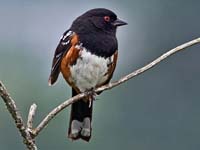THE WORLD BIRDS - An Online Bird Book
PASSERELLIDAE
Order Passeriformes Family Passerellidae
PASSERELLIDAE
The Passerellidae family includes New World brush-finches, juncos, New World sparrows, and towhees. These species were formerly included in the Emberizidae faimiy which now only contains the Old World buntings, They are small seed-eaters with a finch-like bill. In addition to seeds they also eat insects, especially when feeding their young. They build cup-shaped nests.
Towhees
Order Passeriformes Family Passerellidae
Towhees are found only in North and Central America. They have longer tails than most other members of the Passerellidae family.
Gemus Melozone
The Towhees in this genus were previously consider to be part of Pipilo. The genus also contains species termed sparrows. The genus members eat mainly seeds and insects which they mainly find on the ground. Their nest is located on the ground or relatively close to it.
Sparrow,_Prevost's_Ground- Melozone biarcuata
Description: The Prevost's ground-sparrow, aka white-faced ground-sparrow, has olive-brown upperparts. It has rufous crown and neck. The face is white with black patches that vary by subspecies. The bill is dark grey. It has mainly white underparts. The cup-shaped nest is built in a brush or bunch of tall grass. The female builds the nest and incubates the eggs. The male helps feed the chicks. The Prevost's ground-sparrow is about 15 cm long.
Range: Mexico, Central America
Habitat: Forests, woodlands, forest edges.
Diet: Seeds, berries, insects, spiders. It forages on the ground.
Conservation status: Least Concern.
Image by: 1) Richard_Gibbons 2) Tom Benson - Costa Rica 3) Nick Athanas - Mexico 4) MauricioCRRange: Mexico, Central America
Habitat: Forests, woodlands, forest edges.
Diet: Seeds, berries, insects, spiders. It forages on the ground.
Conservation status: Least Concern.
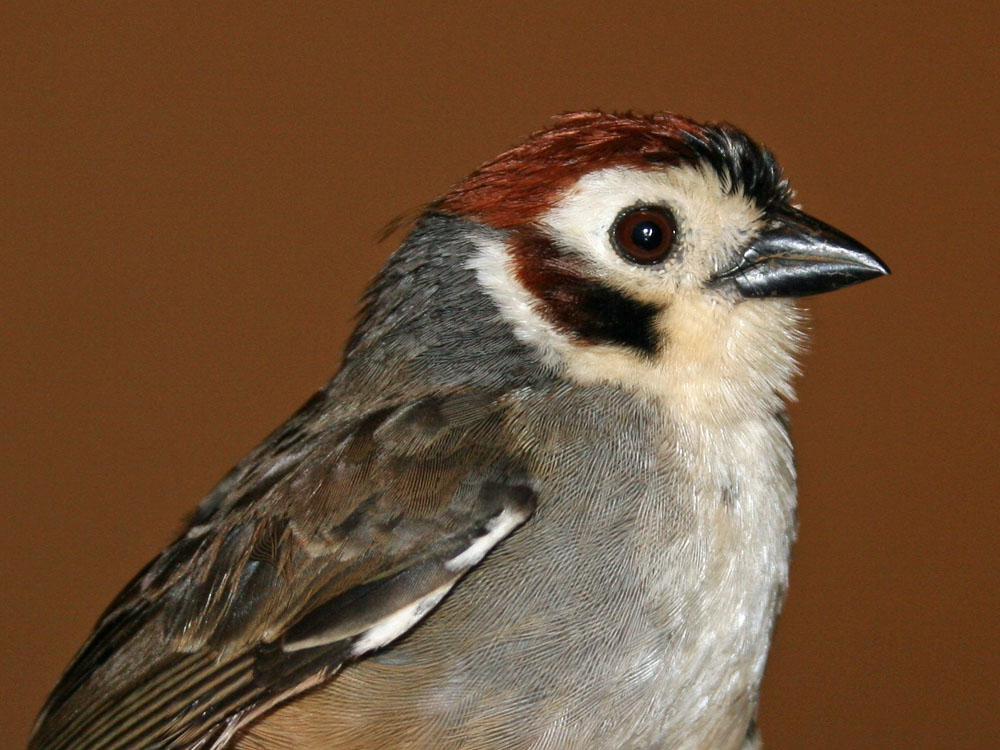



Sparrow,_Rusty-crowned_Ground- Melozone kieneri
Description: The rusty-crowned ground-sparrow has greyish-olive upperparts. It has a mainly rusty head, grey face, and a white crescent eye-ring. The underparts are whitish to grey with a dark central breast patch. The rusty-crowned ground-sparrow is up to 17 cm long.
Range: Western and southwestern Mexico.
Habitat: Forests, degraded forests, shrublands.
Diet: Probably seeds, insects, spiders.
Conservation status: Least Concern.
Image by: 1, 2) Alejando Mercado 3) Ron_KnightRange: Western and southwestern Mexico.
Habitat: Forests, degraded forests, shrublands.
Diet: Probably seeds, insects, spiders.
Conservation status: Least Concern.
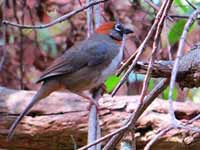
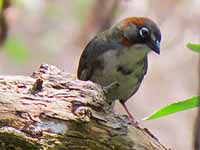

Sparrow, White-eared Ground- Melozone leucotis
Description: The white-eared ground-sparrow has olive-brown upperparts. It has a mainly black head. There is a white patch in front the eyes also one behind eyes, a broken white eye-ring, and a black throat. The bill is blackish. The underparts are mainly white with the breast and grey on the flanks. The white-eared ground-sparrow is about 17 cm. It is easier to sight near dusk. The female builds the nest (which may be on the ground or up to a meter above) and incubates the eggs. The male helps feed the chicks.
Range: Mexico, Central America.
Habitat: Undergrowth and thickets of ravines, forest edge, and other semi-open woodland including second growth and large gardens.
Conservation status: Least Concern.
Image by: 1) Dominic Sherony - Costa Rica 2) Jorge Montejo - Mexico 3) David_Rodriguez_AriasRange: Mexico, Central America.
Habitat: Undergrowth and thickets of ravines, forest edge, and other semi-open woodland including second growth and large gardens.
Conservation status: Least Concern.



Towhee, Abert's Melozone aberti
Description: The Abert's Towhee has grey-brown upperparts. The head is similarly colored with a black mask. It has pinkish-brown underparts. The Abert's Towhee is up to 23 cm long. The similar California Towhee does not have a dark face; their ranges overlap only slightly.
Range: Mainly Arizona. Also bordering states and northern Mexico.
Habitat: Near rivers in: forests, woodlands, shubland.
Diet: Seeds, insects. Forages on the ground.
Conservation status: Least Concern.
Image by: 1) Alan D Wilson - Salton Sea National Wildlife Refuge, California
2) Alan - Salton Sea National Wildlife Refuge 3) Dick Daniels - the North Carolina Zoo 4) Noel_ReynoldsRange: Mainly Arizona. Also bordering states and northern Mexico.
Habitat: Near rivers in: forests, woodlands, shubland.
Diet: Seeds, insects. Forages on the ground.
Conservation status: Least Concern.




Towhee,_California Melozone crissalis
Description: The California towhee has dull brown plumage. It has a light rust colored rump and buff or rust colored streaks on the throat. The California towhee is up to 24 cm long. Its nest is usually off the ground in a tree or shrub.The similar Abert's Towhee has a dark face. The Canyon Towhee has a more prominent eye-ring.
Range: Coastal regions of western Oregon and California in the United States and Baja California Sur in Mexico.
Habitat: Brush, chaparral, open woodlands, and along streams adjacent to desert slopes.
Diet: Seeds, grasses, herbs. Also insects, spiders during breeding season.
Conservation status: Least Concern.
Image by: 1) New Jersy Birds 2) Mathesont 3, 4) Dick Daniels - San Diego, CA Range: Coastal regions of western Oregon and California in the United States and Baja California Sur in Mexico.
Habitat: Brush, chaparral, open woodlands, and along streams adjacent to desert slopes.
Diet: Seeds, grasses, herbs. Also insects, spiders during breeding season.
Conservation status: Least Concern.

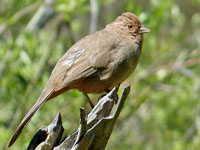
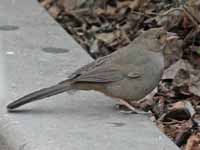

Towhee, Canyon Melozone fusca
Description: The Canyon towhee has brown upperparts and lighter brown underpart. It has a rufous cap on the head except in central Mexico birds. There is a reddish tinge beneath the tail. It has a pale white eye-ring which helps distinguish it from the California Towhee. The Canyon towhee is up to 22 cm long. Its nest is usually off the ground in a tree or shrub.
Range: Southwest US, much of Mexico.
Habitat: Brush or chaparral, desert, rocky terrain. Avoids the coast.
Diet: Mainly seeds; also insects. Will take insects from grills of cars.
Conservation status: Least Concern.
Image by: 1) Alan D Wilson - Arizona 2) Pablo Leautaud 3) Ken Schneider - New Mexico 4) Jerry Oldenettel - New MexicoRange: Southwest US, much of Mexico.
Habitat: Brush or chaparral, desert, rocky terrain. Avoids the coast.
Diet: Mainly seeds; also insects. Will take insects from grills of cars.
Conservation status: Least Concern.
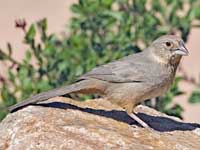


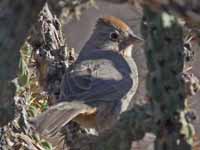
Towhee_ White-throated Melozone albicollis
Description: The white-throated towhee has brown upperparts and lighter underparts. The throat is white with cinnamon above. The white-throated towhee is up to 23 cm long. Its nest is usually on or close to the ground.
Range: Southern Mexico.
Habitat: Montane forests and high altitude shrubland.
Diet: Seeds and insects.
Conservation status: Least Concern.
Image by: 1, 2) Jerry Oldenettel 3) Nick AthanasRange: Southern Mexico.
Habitat: Montane forests and high altitude shrubland.
Diet: Seeds and insects.
Conservation status: Least Concern.

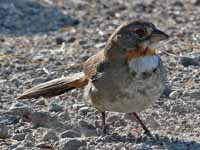

Genus Pipilo
Towhee,_Collared Pipilo ocai
Description: The collared towhee has yellowish-green upperparts. It has a chestnut cap, black cheeks, thin white supercilium, and a white chin. The underparts are pale with a black breast-band. The collared towhee averages 21 cm long.
Range: Southern Mexico.
Habitat: Brush, woodlands.
Diet: Probably seeds, insects, spicers.
Conservation status: Least Concern.
Image by: 1) Jorge Montejo 2) Ryan Shaw 3) Nick Athanas 3) Francesco_VeronesiRange: Southern Mexico.
Habitat: Brush, woodlands.
Diet: Probably seeds, insects, spicers.
Conservation status: Least Concern.



Towhee,_Eastern Pipilo erythrophthalmus
Description: The eastern towhee has black (male) or brown (female) upperparts, head, neck, and tail. It has rufous flanks, a white belly, and a long dark tail. It nests on or near the ground. The similar spotted towhee, which is found in western North America, has spots on its back. Hybrids occur where the range overlaps. The eastern towhee is up to 23 cm long.
Range: Eastern North America.
Habitat: Bushy areas.
Diet: Seeds, fruits, berries, insects. Mainly forages on the ground, but will glean vegetation for insects.
Conservation status: Least Concern.
Image by: 1, 2) Suzanne_Cadwell 43) Dick Daniels - Kennebuck, Maine 4) Bill_Thompson Massachusetts Range: Eastern North America.
Habitat: Bushy areas.
Diet: Seeds, fruits, berries, insects. Mainly forages on the ground, but will glean vegetation for insects.
Conservation status: Least Concern.
1, 2) Female 3, 4) Male




Towhee, Green-tailed Pipilo chlorurus
Description: The green-tailed towhee has mainly grey plumage. the wings and tail are green. It has a distinct white throat, white spot above the lores, and a rufous cap. It is about 18 cm long, which makes it the smallest of its genus.
Range: Western US, Mexico.
Habitat: Shrubland.
Diet: Seeds, insects.
Conservation status: Least Concern.
Image by: 1) Jamie Chavez - California 2, 3) Alan D. Wilson - Oregon 4) Charlie Westerinen- Truckee, CA airportRange: Western US, Mexico.
Habitat: Shrubland.
Diet: Seeds, insects.
Conservation status: Least Concern.
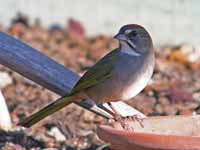



Towhee, Spotted Pipilo maculatus
Description: The spotted towhee is very similar to the eastern towhee. The major difference is the white spots on its mantle. The eastern towhee is found in eastern North America while the spotted is in the west. The eastern towhee may have some white spots, but not as many as the spotted towhee. Hybrids occur where the range overlaps. The spotted towhee is up to 22 cm long.
Range: Western North America.
Habitat: Dry open forests and bushy areas.
Diet: Seeds, fruits, berries, insects. Mainly forages on the ground, especially where this is cover to make it less visable
Conservation status: Least Concern.
Image by: 1) Elaine R Wilson - Reifel Migratory Bird Sanctuary, Ladner, British Columbia 2) Walter Siegmund 3, 5) Alan D Wilson - British Columbia Range: Western North America.
Habitat: Dry open forests and bushy areas.
Diet: Seeds, fruits, berries, insects. Mainly forages on the ground, especially where this is cover to make it less visable
Conservation status: Least Concern.
1, 2) Female 3, 4) Male



